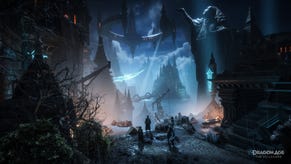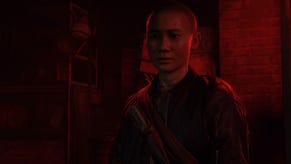Dragon Age: Inquisition learns the lessons of its past
BioWare is drawing on lessons learned from Dragon Age: Origins and the much-maligned-but-actually-quite-good Dragon Age 2 to create Dragon Age: Inquisition, Stace Harman takes a look at this huge RPG to find out more.
Dragon Age: Inquisition, the numberless second sequel to 2009’s Dragon Age: Origins, certainly has its work cut out. Not only is it the biggest game that BioWare Edmonton has ever made, but it will also be launching with the weight of next-gen expectations upon its armoured shoulders and must somehow satisfy fans of its two predecessors, which themselves felt like they were each intended to captivate different audiences.
A first look suggests it’s hitting a number of the important milestones on its way to its intended goals. Firstly, BioWare is packing its huge world full of things to do but allowing you to stumble across them naturally, rather than have convenient goals that funnel you though its hand-crafted locations. This has the effect of presenting what a more open world than Origins while offering a much wider variety of locations than Dragon Age 2.
During a 30-minute gameplay section unveiled at a preview event in London we were shown a town under siege and an assault on a keep. In both cases the surrounding area is packed full of potential diversions. From the traditional sight of the gaping maw of a subterranean cave system to a number of optional quest-giving conversations with NPCs, there’s much more to do than simply fulfil the critical path objective that has brought your party to this area of the world.
“One of the things we're doing differently in Dragon Age Inquisition is giving the player more options in how and when they interact with characters and content,” explains BioWare’s Jonathan Perry. “There’s much more ambient stuff that’s going on in the world around you so there's less of the player crossing an invisible trigger and us taking away control in order to direct them towards something specific.”
There’s also a greater freedom in how you approach a particular goal and with that comes a wider array of consequences of your actions. As a leading member of the titular Inquisition your primary objective is to establish the nature and cause of a number of Fade Rifts that have been cropping up all over Ferelden and the wider expanse of Thedas.
This focus on the bigger picture can sometimes clash with local interests, so when charged with investigating a Fade Rift in Crestwood you can choose either to aid the villagers directly to repel the advance of the Red Templars or instead pull back to the Inquisition’s local keep to shore-up defences.
The intention is to promote a feeling of having to choose the lesser of two evils and to have your role as Inquisitor defined by your actions, rather than by a series of binary dialogue choices. In this case, aiding the villagers is the more humane option but it also carries with it weight of the knowledge that you’re weakening the Inquisition’s position by giving up an established stronghold. Conversely, to choose to protect the keep is to abandon the villagers to a grisly end and either way you run the risk of upsetting one of your three companions, who aren’t shy about voicing their displeasure.
“I certainly want to stay away from kind of lace-underwear-Victoria-Secret-lingerie that was in Origins because that was a little out of place – I’d hate to imagine what underwear would really be like after questing all day.”
A number of new characters line up alongside returning cast members like dwarf Varric Tethras and human warrior Cassandra Pentaghast, and with those familiar faces comes the humorous interactions between party members in the form of incidental conversations and in-fighting. Of course, being a BioWare game there’s also the potential for love or lust to blossom and because he’s personally responsible for the direction and tone of the in-game cinematics, Perry is adamant that the team is mindful of the lessons of BioWare’s previous experiments in this area.
“The direction I'd like to take the relationship scenes in is like they were in Mass Effect, where you might have a character that's nude but they silhouetted or in shadow, so it's tastefully sensual and not graphic.
“I certainly want to stay away from kind of lace-underwear-Victoria-Secret-lingerie that was in Origins because that was a little out of place – I'd hate to imagine what underwear would really be like after questing all day.”
The improved graphical fidelity of next-gen machines and the Frostbite 3 engine will allow Perry and team to do more than render semi-convincing love scenes. You’ll also see your adventure reflected by the appearance of your character, with armour scuffing and becoming caked in mud and blood (although Perry is keen to steer clear of the comedic levels of splatter seen in Origins). For there to be blood splatter there has to be combat and it’s here that Inquisition is truly a product of its forebears.
While the default camera is an over the shoulder third person view, during combat there’s the option to switch to the tactical view first seen in Origins. In tactical view the action is paused, allowing you to pan around the battlefield and switch between the members of your party to issue commands, before unpausing and either continuing in tactical mode or switching back to the Mass Effect-style shoulder cam.
Perry guides us through a keep-assault section, showing how abilities of warrior, mage and rogue can be combined for some interclass combos and it looks familiar enough to satisfy franchise fans while offering greater flexibility than its predecessors. Upon liberating the keep there’s the option to install Inquisition troops and customise it with a specialty, such as espionage and politicking or military might, which will open-up more quest options later on.
A more comprehensive, hands-on exploration of Dragon Age: Inquisition will be necessary before any conclusions can be drawn about how it plays. However, this first look at some pre-alpha game play suggests BioWare has taken to heart the feedback it’s received to its previous Dragon Age titles and intends to deliver a game that captures the best of its output when it launches late next year.











